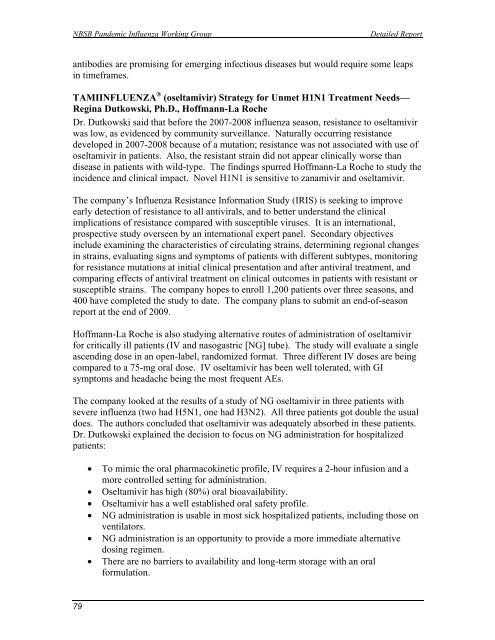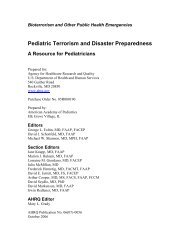H1N1 COUNTERMEASURES STRATEGY AND ... - PHE Home
H1N1 COUNTERMEASURES STRATEGY AND ... - PHE Home
H1N1 COUNTERMEASURES STRATEGY AND ... - PHE Home
You also want an ePaper? Increase the reach of your titles
YUMPU automatically turns print PDFs into web optimized ePapers that Google loves.
NBSB Pandemic Influenza Working Group<br />
Detailed Report<br />
antibodies are promising for emerging infectious diseases but would require some leaps<br />
in timeframes.<br />
TAMIINFLUENZA ® (oseltamivir) Strategy for Unmet <strong>H1N1</strong> Treatment Needs—<br />
Regina Dutkowski, Ph.D., Hoffmann-La Roche<br />
Dr. Dutkowski said that before the 2007-2008 influenza season, resistance to oseltamivir<br />
was low, as evidenced by community surveillance. Naturally occurring resistance<br />
developed in 2007-2008 because of a mutation; resistance was not associated with use of<br />
oseltamivir in patients. Also, the resistant strain did not appear clinically worse than<br />
disease in patients with wild-type. The findings spurred Hoffmann-La Roche to study the<br />
incidence and clinical impact. Novel <strong>H1N1</strong> is sensitive to zanamivir and oseltamivir.<br />
The company’s Influenza Resistance Information Study (IRIS) is seeking to improve<br />
early detection of resistance to all antivirals, and to better understand the clinical<br />
implications of resistance compared with susceptible viruses. It is an international,<br />
prospective study overseen by an international expert panel. Secondary objectives<br />
include examining the characteristics of circulating strains, determining regional changes<br />
in strains, evaluating signs and symptoms of patients with different subtypes, monitoring<br />
for resistance mutations at initial clinical presentation and after antiviral treatment, and<br />
comparing effects of antiviral treatment on clinical outcomes in patients with resistant or<br />
susceptible strains. The company hopes to enroll 1,200 patients over three seasons, and<br />
400 have completed the study to date. The company plans to submit an end-of-season<br />
report at the end of 2009.<br />
Hoffmann-La Roche is also studying alternative routes of administration of oseltamivir<br />
for critically ill patients (IV and nasogastric [NG] tube). The study will evaluate a single<br />
ascending dose in an open-label, randomized format. Three different IV doses are being<br />
compared to a 75-mg oral dose. IV oseltamivir has been well tolerated, with GI<br />
symptoms and headache being the most frequent AEs.<br />
The company looked at the results of a study of NG oseltamivir in three patients with<br />
severe influenza (two had H5N1, one had H3N2). All three patients got double the usual<br />
does. The authors concluded that oseltamivir was adequately absorbed in these patients.<br />
Dr. Dutkowski explained the decision to focus on NG administration for hospitalized<br />
patients:<br />
<br />
<br />
<br />
<br />
<br />
<br />
To mimic the oral pharmacokinetic profile, IV requires a 2-hour infusion and a<br />
more controlled setting for administration.<br />
Oseltamivir has high (80%) oral bioavailability.<br />
Oseltamivir has a well established oral safety profile.<br />
NG administration is usable in most sick hospitalized patients, including those on<br />
ventilators.<br />
NG administration is an opportunity to provide a more immediate alternative<br />
dosing regimen.<br />
There are no barriers to availability and long-term storage with an oral<br />
formulation.<br />
79
















